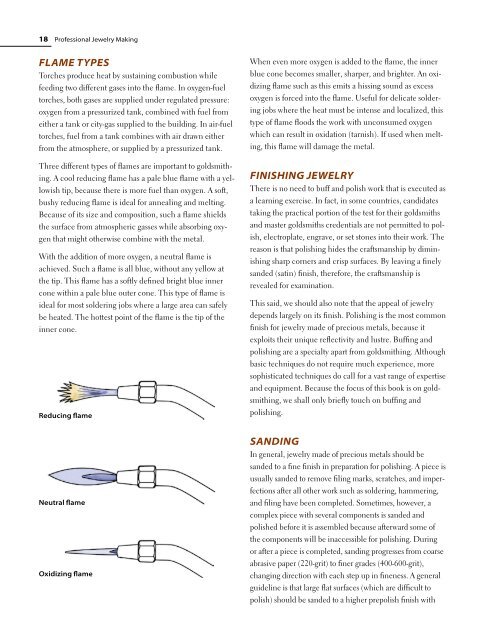Professional Jewelry Making - Brynmorgen Press
Professional Jewelry Making - Brynmorgen Press
Professional Jewelry Making - Brynmorgen Press
Create successful ePaper yourself
Turn your PDF publications into a flip-book with our unique Google optimized e-Paper software.
18 <strong>Professional</strong> <strong>Jewelry</strong> <strong>Making</strong><br />
flAme tYPes<br />
Torches produce heat by sustaining combustion while<br />
feeding two different gases into the flame. In oxygen-fuel<br />
torches, both gases are supplied under regulated pressure:<br />
oxygen from a pressurized tank, combined with fuel from<br />
either a tank or city-gas supplied to the building. In air-fuel<br />
torches, fuel from a tank combines with air drawn either<br />
from the atmosphere, or supplied by a pressurized tank.<br />
Three different types of flames are important to goldsmithing.<br />
A cool reducing flame has a pale blue flame with a yellowish<br />
tip, because there is more fuel than oxygen. A soft,<br />
bushy reducing flame is ideal for annealing and melting.<br />
Because of its size and composition, such a flame shields<br />
the surface from atmospheric gasses while absorbing oxygen<br />
that might otherwise combine with the metal.<br />
With the addition of more oxygen, a neutral flame is<br />
achieved. Such a flame is all blue, without any yellow at<br />
the tip. This flame has a softly defined bright blue inner<br />
cone within a pale blue outer cone. This type of flame is<br />
ideal for most soldering jobs where a large area can safely<br />
be heated. The hottest point of the flame is the tip of the<br />
inner cone.<br />
Reducing flame<br />
Neutral flame<br />
Oxidizing flame<br />
When even more oxygen is added to the flame, the inner<br />
blue cone becomes smaller, sharper, and brighter. An oxidizing<br />
flame such as this emits a hissing sound as excess<br />
oxygen is forced into the flame. Useful for delicate soldering<br />
jobs where the heat must be intense and localized, this<br />
type of flame floods the work with unconsumed oxygen<br />
which can result in oxidation (tarnish). If used when melting,<br />
this flame will damage the metal.<br />
fInIsHIng JewelrY<br />
There is no need to buff and polish work that is executed as<br />
a learning exercise. In fact, in some countries, candidates<br />
taking the practical portion of the test for their goldsmiths<br />
and master goldsmiths credentials are not permitted to polish,<br />
electroplate, engrave, or set stones into their work. The<br />
reason is that polishing hides the craftsmanship by diminishing<br />
sharp corners and crisp surfaces. By leaving a finely<br />
sanded (satin) finish, therefore, the craftsmanship is<br />
revealed for examination.<br />
This said, we should also note that the appeal of jewelry<br />
depends largely on its finish. Polishing is the most common<br />
finish for jewelry made of precious metals, because it<br />
exploits their unique reflectivity and lustre. Buffing and<br />
polishing are a specialty apart from goldsmithing. Although<br />
basic techniques do not require much experience, more<br />
sophisticated techniques do call for a vast range of expertise<br />
and equipment. Because the focus of this book is on goldsmithing,<br />
we shall only briefly touch on buffing and<br />
polishing.<br />
sAndIng<br />
In general, jewelry made of precious metals should be<br />
sanded to a fine finish in preparation for polishing. A piece is<br />
usually sanded to remove filing marks, scratches, and imperfections<br />
after all other work such as soldering, hammering,<br />
and filing have been completed. Sometimes, however, a<br />
complex piece with several components is sanded and<br />
polished before it is assembled because afterward some of<br />
the components will be inaccessible for polishing. During<br />
or after a piece is completed, sanding progresses from coarse<br />
abrasive paper (220-grit) to finer grades (400-600-grit),<br />
changing direction with each step up in fineness. A general<br />
guideline is that large flat surfaces (which are difficult to<br />
polish) should be sanded to a higher prepolish finish with




